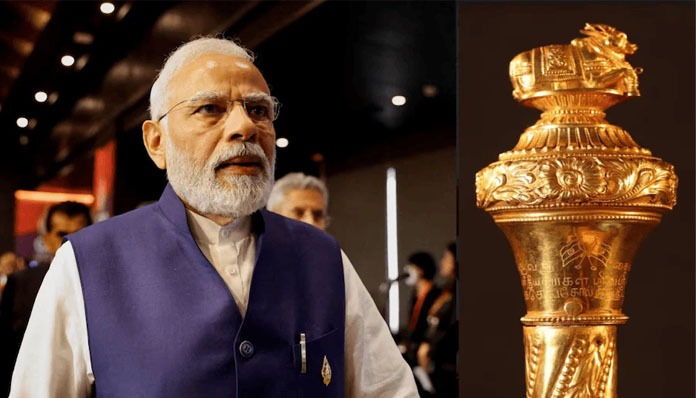The ‘Sengol’ sent from Tamil Nadu in 1947 to symbolize power transition from the British back to the Bharathiyas, was lying in the Anand Bhavan – the historic house museum of the Nehru family at Allahabad in Prayagraj labelled as Nehru’s ‘Golden walking stick’ all these years.
What a blunder!
The ‘Sengol’ is neither any ‘walking stick’ nor any decorative museum piece. It means a whole lot of things essentially, emotionally, spiritually, culturally, traditionally and sentimentally.
‘Sengol’ is a Tamil word for ‘sceptre’ which is derived from two Tamil words – ‘Semmai’ which means ‘righteous’ and ‘kol’ which means ‘sceptre.’ Sengol is also called the “Dharma Danda” where ‘Dharma’ means ‘righteousness’ and ‘Danda’ means ‘a stick / staff.’
The Sengol has a significant cultural value and is the historical heritage of the Tamil Kings to abided by the Kshatriya Dharma as directed by the Dharma Shastras.
Sengol is handed over to the new King on coronation by the Head Priest amidst auspicious mantras chanted in ceremonial proceedings. The handing over of the Sengol symbolizes ‘transfer of Power’ from the previous King to the new King.
A Sengol is usually made up of pure gold, silver or gold plated on silver. Some of them may be studded with precious stones and gems. They may contain ornamented royal emblems or sacred depictions of the land/ Kingdom.
A Sengol is the depiction of –
- righteousness,
- ethical and virtuous rules,
- authority and sovereignty,
- power and lawfulness,
- embodiment of justice.
A Sengol in the hands of the Ruler reminds him of his Kshatriya duty to –
- protect the Matru Bhoomi and the citizens,
- adherence to the principles of Dharma,
- safeguard Dharma
- ensure fair and equitable governance, and
- ensue justice.
When the British colonizers finally decided to leave Bharat and hand over the governance back to the Bharathiyas, the last Viceroy of British colonized India – Lord Mountbatten enquired with Pandit Jawaharlal Nehru about the Bharathiya native ceremonial ritual of transfer of power. Nehru assigned the task to Shri C.Rajagopalachari who was the then Governor General of British colonized Bharat.
Rajaji suggested the Sengol handing-over ritual followed by the Tamil Kingdoms traditionally. To be specific, he recommended the Chola traditional Sengol among the several other Dynasties’ sceptres. The responsibility to design and get the Sengol made was handed over to the Shaivite Mutt – the Thiruvaduthurai Aatheenam Mutt. Vummidi Bangaru Chetty Jewellers crafted the historical 5-foot-long Sengol with the Nandi Bull at the top.
Nandikesvara is the loyal bull vehicle of Bhagwan Shiva and the guardian Deity of Kailash – the abode of Bhagwan Maheshwara and Devi Parvati, according to native Indic belief and Scriptures.
The Bull is a symbol of stability. Further, the sitting posture of Nandi shows the stability sitting on the four legs (pillars) of Dharma. In Srimad Bhagavatam, Dharma is depicted as the Bull and its four legs are austerity (duty-conscious with will-power), cleanliness (purity of soul and clarity of thought and action), kindness (compassion, charity and welfare) and truthfulness (Satya). Nandi also signifies strength, focus and happiness. Nandi is said to be the protector of Dharma (Righteousness) and Justice.
On the night of 14th August, 1947, the shift of power from the British colonizers back to the Bharathiyas to mark the Independence of Bharat from the British colonial rule was marked in the traditional royal way of handing over the Sengol besides the signing of the formal documents and fulfilling other legal formalities.
In the pious ceremonial mode, the Holy water from the Ganges (Ganga Jal) was sprinkled on the Sengol with the chanting of Mantras. The Sengol was given to Lord Mountbatten. Then, Lord Mountbatten handed over the Sengol to the Aatheenam who was the Spiritual Guru invited for the event. With the Mangala Vadhiyam (Divine musical instruments) of Nadaswaram being played and the Oduvars (Priests) chanting the Sacred recitation “Kolaru Pathigam” from Thirugnyana Sambandar’s Thevaram, the Aatheenam handed over the Sengol to Pandit Jawaharlal Nehru, the First Prime Minister of Independent Bharat, as a historic event.
After Independence, this highly significant Sengol was left insignificantly inside the glass box as a museum piece with a false labelling as Nehru’s ‘Golden walking stick’ not only insulting the sentiments of the Tamil tradition but also having misguided the citizens of Bharat with the misinformation.
Unfortunately, with just some scattered information about the Sengol recorded in few books, information about this Sengol vanished into just letters and words in those few dust-heaped books kept in some remote libraries and archives.
Thanks to those dedicated Historians and Researchers who hunted these books, dusted their pages, and pulled out records and evidences, to give life to the Sengol.
Now, the Central Government has decided to take the Sengol out of the display glass desk and install it near the seat of the Speaker in the New Parliament building which would be inaugurated on 28th of May, 2023 by the Honourable Prime Minister of Bharat, Shri Narendra Modiji.
Hereafter, the Sengol will cease to be the 75-years’ exhibit item and become an active symbolism of Dharma.
The Sengol is no longer Nehru’s ‘Golden walking stick’ but, is the embodiment of Dharma (Righteousness) instrumental in Governing the Nation in accordance to the Rule of Law – the Constitution of India for the welfare, peace. and progress of the Nation.
It is great pride for the Tamilars and entire Bharat to cherish the very thought of the event when the traditional Sengol will be receiving its due acknowledgement on the 28th in the New Parliament Building inauguration function when the Divine procession with Sacred Chantings, Sacred Fire pooja – Homam (Havan), Divine music and the team of twenty Aatheenams would bestow the Sengol to the Prime Minister with all their Divine Blessings to be installed on the pedestal to the right of the Speaker’s Chair.
Ultimately the historic Sengol gets its due honour, recognition, and place in the Nation!

